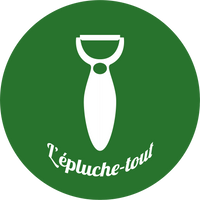How to use the peeler
The peeler (Fig. A):
• (1) double serrated blades that grip the flesh of the fruit and peel in both directions
• (2) U: strips in pulp and skin
• (3) orange peeler

And again... (Fig. B):
• (1) Pinking knife (snapped into the handle)
• (2) Ring with 2 wings to remove the stem of citrus fruits (in the pinking knife)
• (3) V: strips in zest

Maintenance: Simply pass the multifunctional decorative set under hot water - with a brush to remove stubborn residues.
Function 1: peeling
Like peppers. First remove the protective cap. Pass the blade along the pepper (Fig. 1). Very economical, the peeler is designed to remove extra-fine peels. Always work in portions, top then bottom, or front then back. The peeler works from top to bottom as well as bottom to top. Its finely toothed double blade allows you to work quickly and with great accuracy (be careful, it is sharp!)

Function 2: The U to decorate
For the example of the zucchini: hold the handle of the peeler horizontally, the U resting on the zucchini (Fig. 2). Pass over the entire length of the vegetable with light and even pressure. Always work towards yourself. Bring the U back in the same furrow to the starting point before making a new furrow and repeating the operation all around the vegetable. The U makes it easy to decorate a wide variety of fruits and vegetables with lots of imagination.

Chef's suggestion: Do not leave too much space between the furrows to obtain a nice floral effect. Once incised, immerse the radishes for 30 minutes in ice water to see them bloom like flowers.
Function 3: The V to flute your fruit
Like the orange. The protective cap is in place on the blade. Hold the handle of the peeler horizontally, pass the V over the peel of the orange constantly from top to bottom to lift a thin layer of zest. These strips can then be braided, folded over in the furrow or laid diagonally in the next (Fig. 3). Unlimited decoration possibilities...

Function 4: The notched cut
Like the pear. The protective cap is in place on the blade! Lower the small valve inside the handle by pressing simultaneously with the thumb on the V: the element to be notched is released from the handle. Just fold it down completely as an extension of the handle. Make the cuts all around the pear, piercing all the way to the heart (Fig. 4). Proceed in this way all around, leaving intervals of about 1.5 cm. Separate the two halves of the fruit which are nicely notched.

Function 5: Remove the peduncle of citrus fruits
Like the lemon. The protective cap is in place on the blade, the serrated knife extending from the handle. Place the 4-winged ring (which is located at the base of the internal side of the element to be detented) exactly on the stalk of the fruit (Fig. 5). Turn back and forth, exerting a certain pressure to extract the latter. Put the pinking knife back in place in the handle by clicking the small flap.

Function 6: Orange peeler
Start by removing the peduncle as explained above (Fig. 5). Put the pinking knife back in place by clicking the small flap: the debarker is located next to the V, the protective cap being necessarily in place on the blade. plant the debarker in the hollow of the peduncle and slide it upwards to split the bark. Move the debarker 3 cm and continue in the same way. Use the serrated knife to remove the quarters of bark thus marked out (Fig 7).






